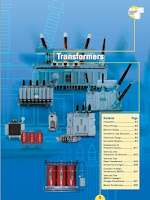TRANSFORMER CATALOGUE: A SAMPLE FROM MANUFACTURER
Transformers are one of the primary components for the transmission and distribution of electrical energy. Their design results mainly from the range of application, the construction, the rated power and the voltage level. The scope of transformer types starts with generator transformers and ends with distribution transformers. Transformers which are directly connected to the generator of the power station are called generator transformers. Their power range goes up to far above 1000 MVA. Their voltage range extends to approx.1500 kV. The connection between the different highvoltage system levels is made via network transformers (network interconnecting transformers). Their power range exceeds 1000 MVA. The voltage range exceeds 1500 kV. Distribution transformers are within the range from 50 to 2500 kVA and max. 36 kV. In the last step, they distribute the electrical energy to the consumers by feeding from the high-voltage into the low-voltage distribution network. These are designed either as liquid-filled or as dry-type transformers. Transformers with a rated power up to 2.5 MVA and a voltage up to 36 kV are referred to as distribution transformers; all transformers of higher ratings are classified as power transformers.
 In addition, there are various specialpurpose transformers such as converter transformers, which can be both in the range of power transformers and in the range of distribution transformers as far as rated power and rated voltage are concerned. As special elements for network stabilization, arc-suppression coils and compensating reactors are available. Arc-suppression coils compensate the capacitive current flowing through a ground fault and thus guarantee uninterrupted energy supply. Compensating reactors compensate
In addition, there are various specialpurpose transformers such as converter transformers, which can be both in the range of power transformers and in the range of distribution transformers as far as rated power and rated voltage are concerned. As special elements for network stabilization, arc-suppression coils and compensating reactors are available. Arc-suppression coils compensate the capacitive current flowing through a ground fault and thus guarantee uninterrupted energy supply. Compensating reactors compensatethe capacitive power of the cable networks and reduce overvoltages in case of load rejection; the economic efficiency and stablility of the power transmission are improved. The general overview of our manufacturing/delivery program is shown in the table ”Product Range“.
Comments
Post a Comment